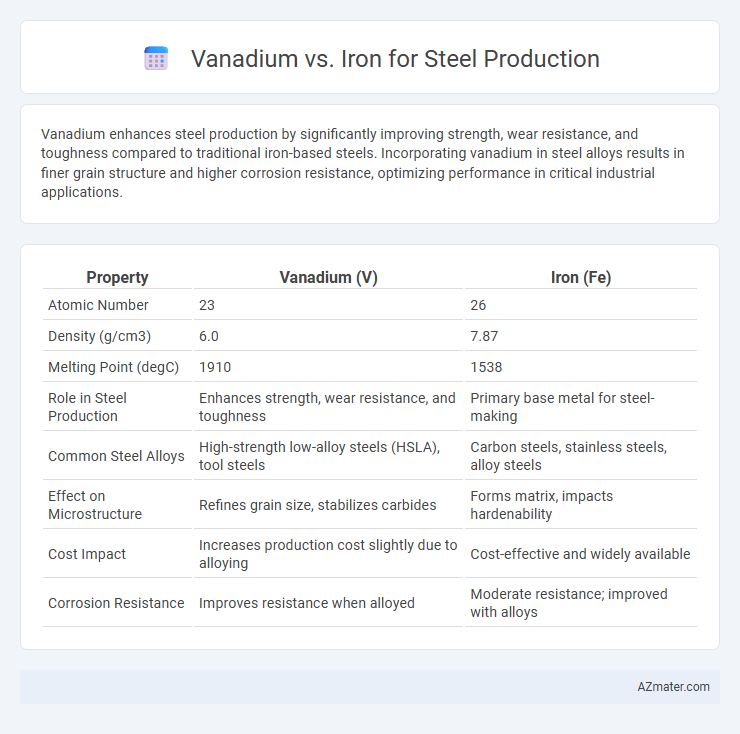Vanadium enhances steel production by significantly improving strength, wear resistance, and toughness compared to traditional iron-based steels. Incorporating vanadium in steel alloys results in finer grain structure and higher corrosion resistance, optimizing performance in critical industrial applications.
Table of Comparison
| Property | Vanadium (V) | Iron (Fe) |
|---|---|---|
| Atomic Number | 23 | 26 |
| Density (g/cm3) | 6.0 | 7.87 |
| Melting Point (degC) | 1910 | 1538 |
| Role in Steel Production | Enhances strength, wear resistance, and toughness | Primary base metal for steel-making |
| Common Steel Alloys | High-strength low-alloy steels (HSLA), tool steels | Carbon steels, stainless steels, alloy steels |
| Effect on Microstructure | Refines grain size, stabilizes carbides | Forms matrix, impacts hardenability |
| Cost Impact | Increases production cost slightly due to alloying | Cost-effective and widely available |
| Corrosion Resistance | Improves resistance when alloyed | Moderate resistance; improved with alloys |
Introduction to Vanadium and Iron in Steel Production
Vanadium and iron are critical elements in steel production, with iron serving as the primary base metal forming the steel matrix. Vanadium is added in small quantities to enhance steel's strength, hardness, and wear resistance by forming stable carbides and refining grain size. The strategic use of vanadium improves steel performance in construction, automotive, and aerospace industries by increasing durability and reducing weight compared to plain iron-based steels.
Chemical Properties: Vanadium vs Iron
Vanadium exhibits higher oxidation resistance and forms stable carbides and nitrides, enhancing steel's strength, toughness, and wear resistance compared to iron. Iron primarily contributes to steel's magnetic properties and ductility but lacks vanadium's ability to refine grain structure and improve alloy hardness through microalloying. The chemical synergy between vanadium's ability to form complex intermetallic compounds and iron's base matrix creates superior high-performance steels used in demanding industrial applications.
Historical Role of Iron in Steelmaking
Iron has been the foundational element in steel production for millennia, serving as the primary metal due to its abundance and favorable properties such as malleability and tensile strength. Its historical dominance in steelmaking is rooted in the development of techniques like smelting and carburization, which enabled the transformation of iron ore into durable steel alloys. While vanadium is now recognized for enhancing steel's strength and corrosion resistance through microalloying, iron remains the core constituent of steel, maintaining its critical role in structural and industrial applications.
Emergence of Vanadium-Alloyed Steel
Vanadium-alloyed steel has emerged as a superior alternative to traditional iron-based steel due to its enhanced strength, corrosion resistance, and fatigue performance, making it ideal for demanding industrial applications such as automotive manufacturing and structural engineering. The addition of vanadium refines grain structure and improves microhardness, resulting in steels with increased tensile strength and wear resistance at reduced material thicknesses. This advancement is driven by vanadium's ability to form stable carbides and nitrides, which significantly improve the mechanical properties compared to conventional iron steels, leading to lighter, more durable, and energy-efficient steel products.
Mechanical Strength and Performance Comparison
Vanadium significantly enhances the mechanical strength and performance of steel by promoting grain refinement and increasing tensile strength, toughness, and fatigue resistance compared to iron alone. Its ability to form stable carbides and nitrides improves wear resistance and hardenability, making vanadium-alloyed steel ideal for demanding applications such as automotive, aerospace, and construction industries. In contrast, plain iron-based steel lacks these microstructural benefits, resulting in lower strength and reduced performance under high-stress conditions.
Corrosion Resistance: Vanadium vs Iron-Steel
Vanadium-enhanced steel exhibits superior corrosion resistance compared to standard iron-based steel due to the formation of stable vanadium carbides and nitrides that inhibit oxidation and material degradation. The microalloying effect of vanadium refines grain structure, improving toughness and reducing susceptibility to rust in harsh environments. Iron-steel without vanadium lacks these protective phases, making it more prone to corrosion and requiring additional coatings or treatments for durability.
Cost Analysis and Economic Considerations
Vanadium enhances steel strength and hardness, allowing for lower quantities in alloy composition compared to iron, which can reduce overall material costs despite its higher unit price. The economic consideration for vanadium involves balancing its premium cost against improved performance, longer lifespan, and reduced maintenance of vanadium-strengthened steel products. Iron remains the primary base metal due to abundant availability and lower cost, but integrating vanadium optimizes steel production cost-effectiveness in high-performance applications.
Sustainability and Environmental Impact
Vanadium significantly enhances steel strength and durability while allowing for lower steel mass, reducing raw material extraction and energy consumption, contributing to sustainability in steel production. Iron remains the primary metal in steelmaking but requires higher energy inputs and produces more CO2 emissions due to larger quantities needed for equivalent structural performance. Using vanadium-alloyed steel supports environmental impact reduction by enabling lighter, longer-lasting structures and decreasing the overall carbon footprint of steel manufacturing.
Applications in Modern Industries
Vanadium enhances steel production by significantly improving strength, toughness, and corrosion resistance, making it ideal for aerospace, automotive, and construction industries where high-performance materials are crucial. Iron, as the primary element in steel, provides a cost-effective base but lacks the enhanced mechanical properties that vanadium alloys offer. Modern industries prioritize vanadium-alloyed steels for critical applications such as pipelines, tool steels, and structural components requiring durability and lightweight performance.
Future Trends in Steel Alloying: Vanadium vs Iron
Vanadium increasingly outperforms iron in steel production due to its superior ability to enhance strength, hardness, and corrosion resistance at lower alloy percentages. Emerging trends emphasize vanadium microalloying for high-strength low-alloy (HSLA) steels, crucial for lightweight automotive and infrastructure applications demanding improved fuel efficiency and sustainability. Research highlights vanadium's role in reducing carbon footprints by enabling stronger, thinner steel components, positioning it as a key element in future alloy development over traditional iron-centric blends.

Infographic: Vanadium vs Iron for Steel Production
 azmater.com
azmater.com